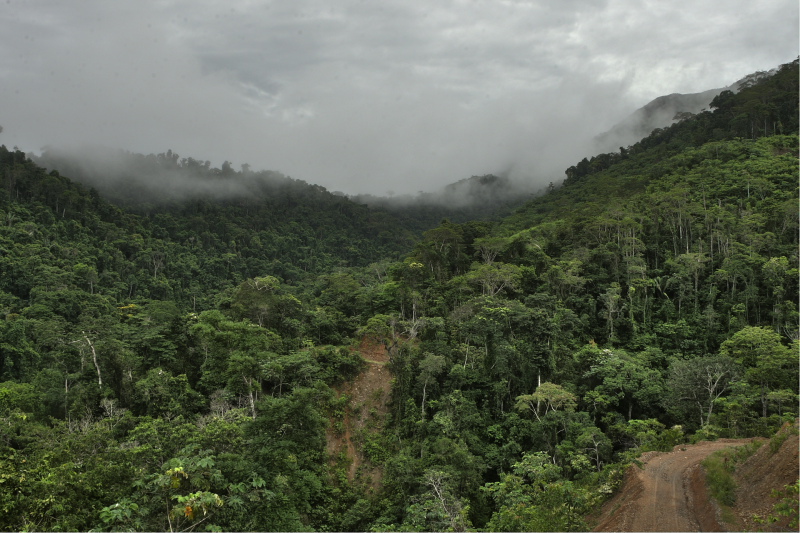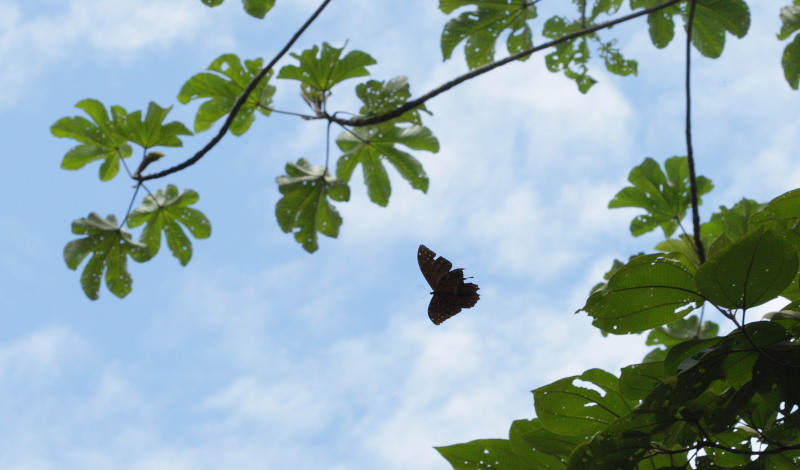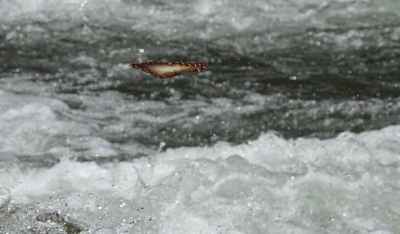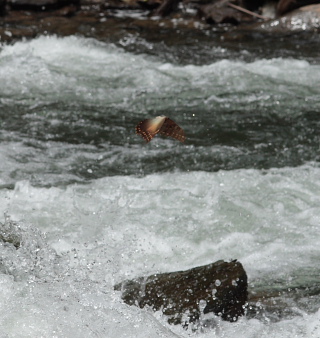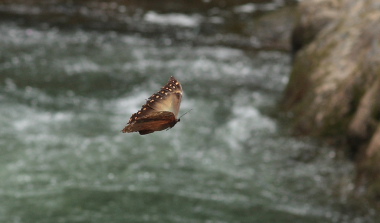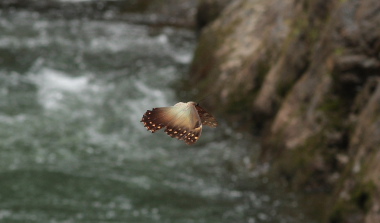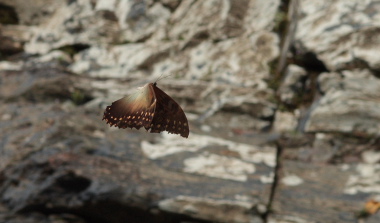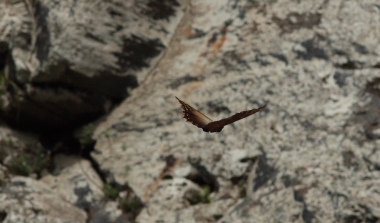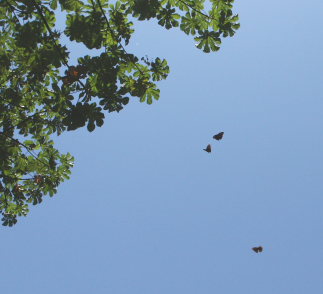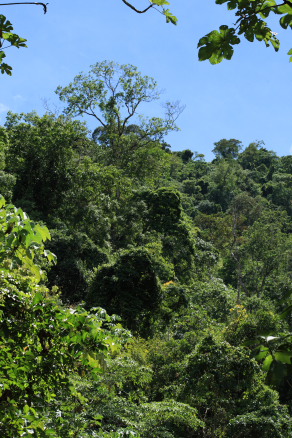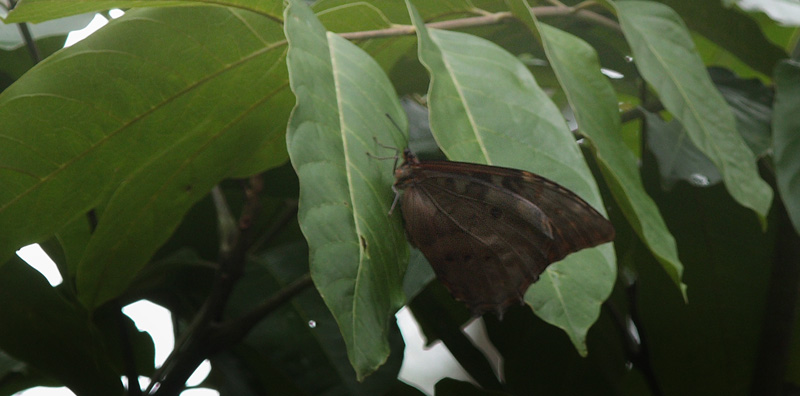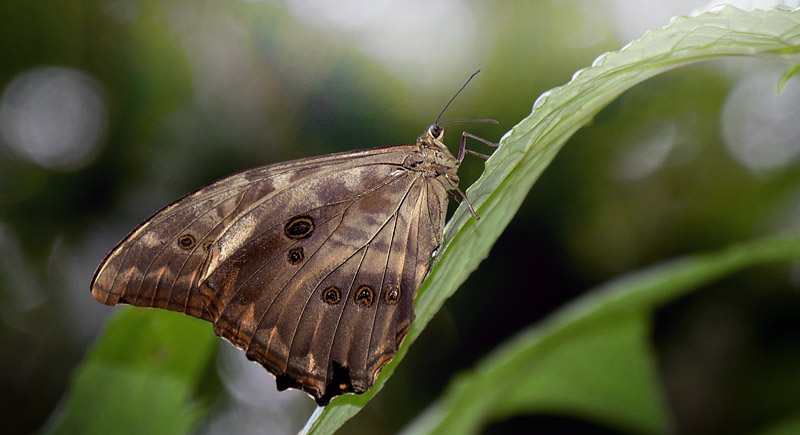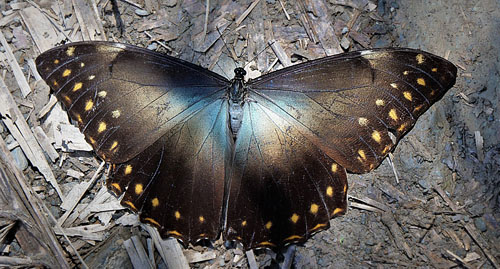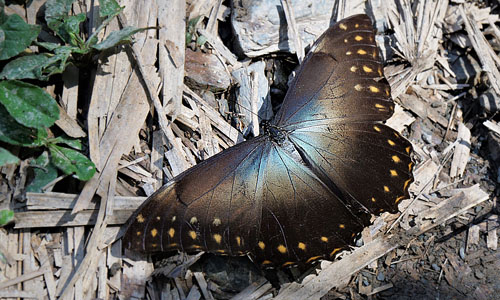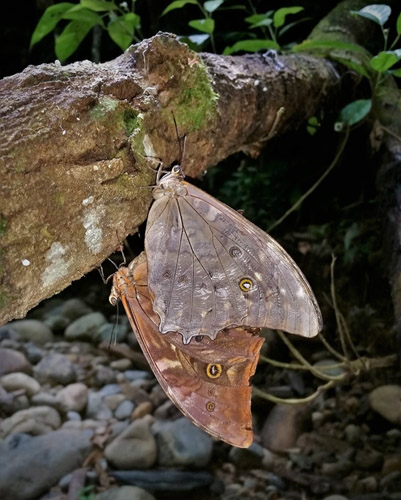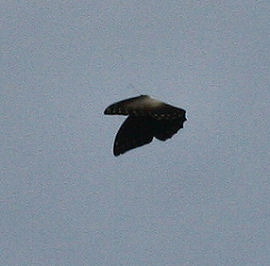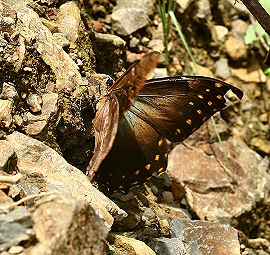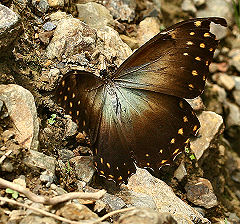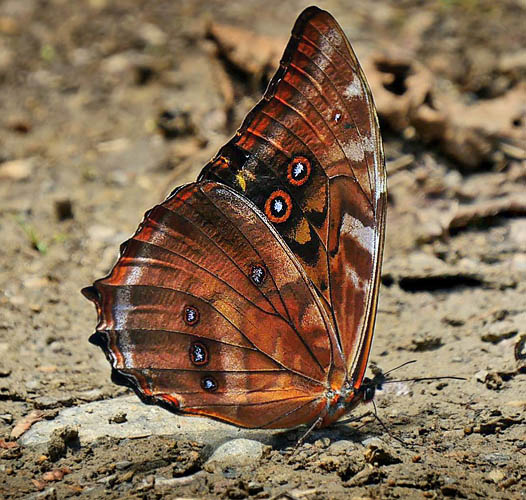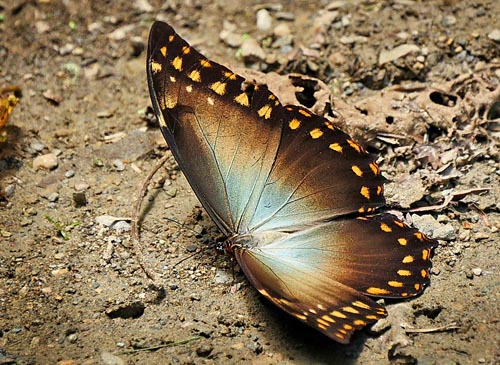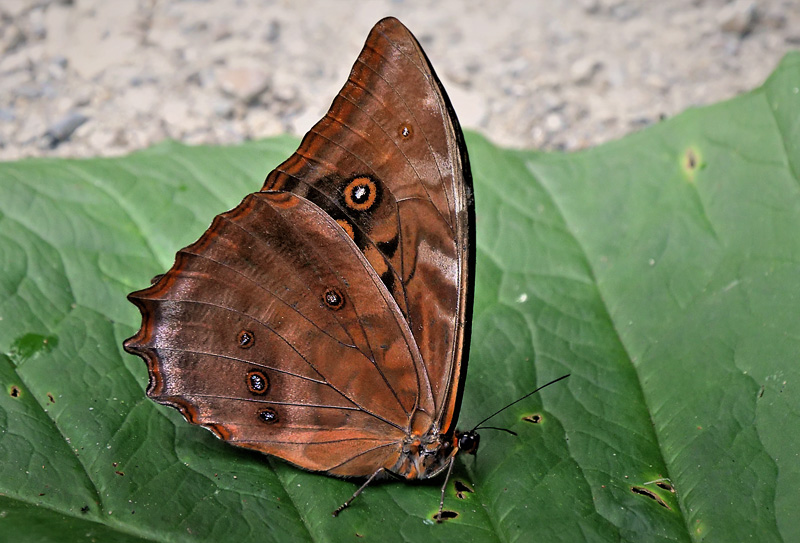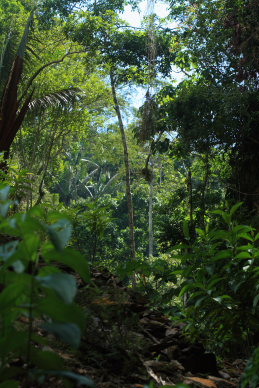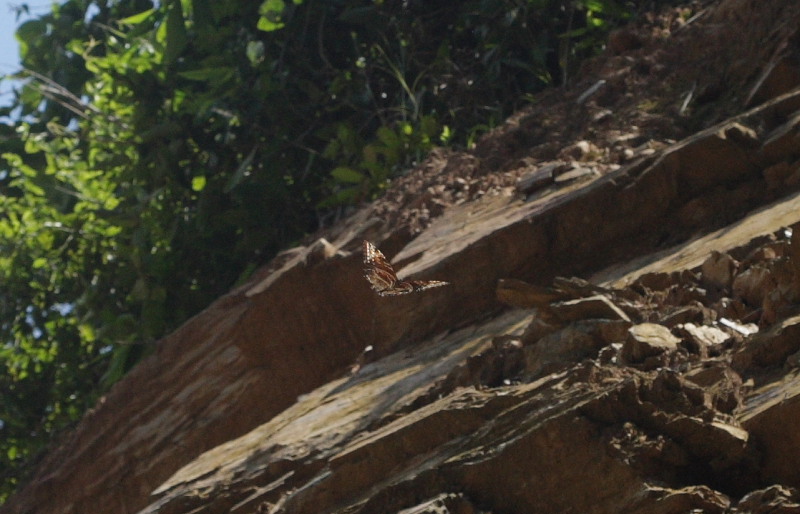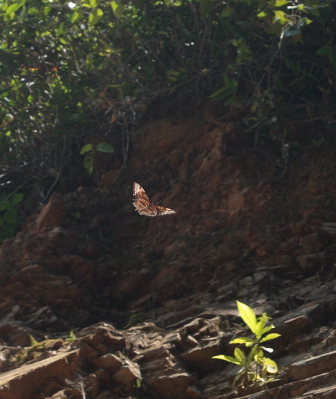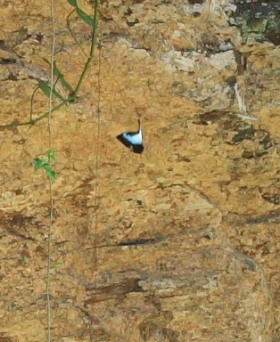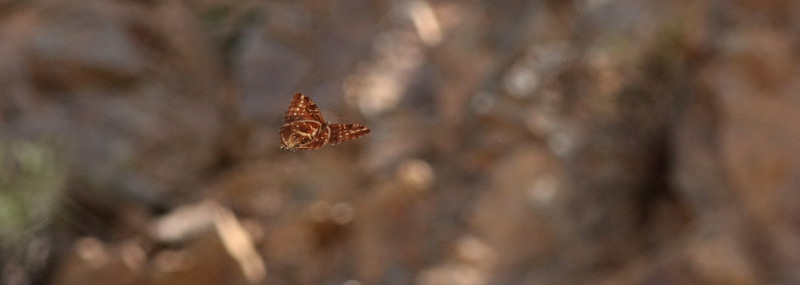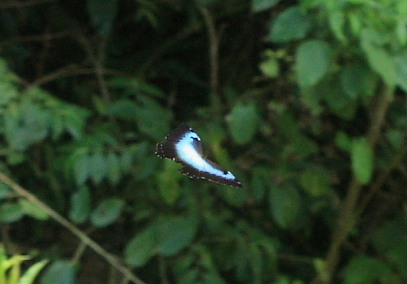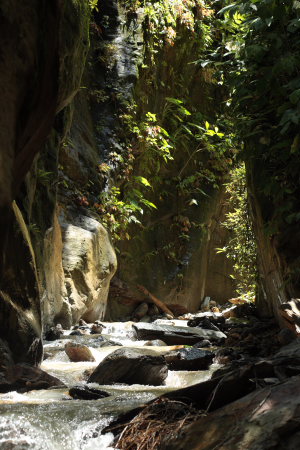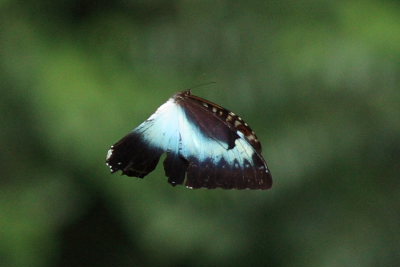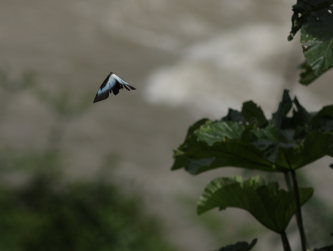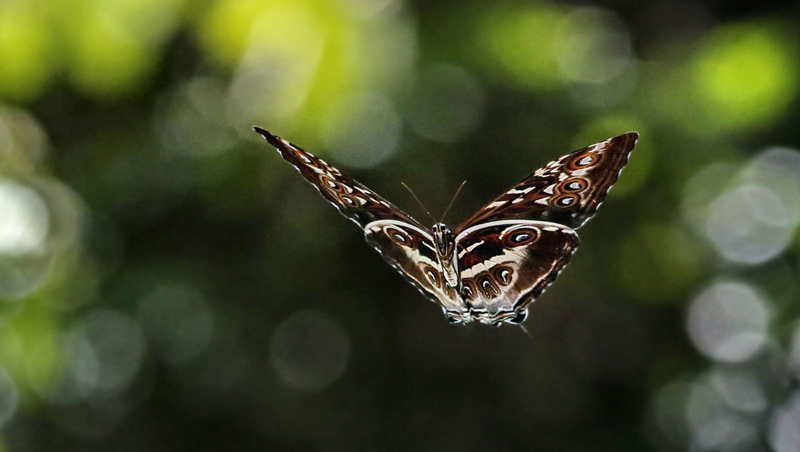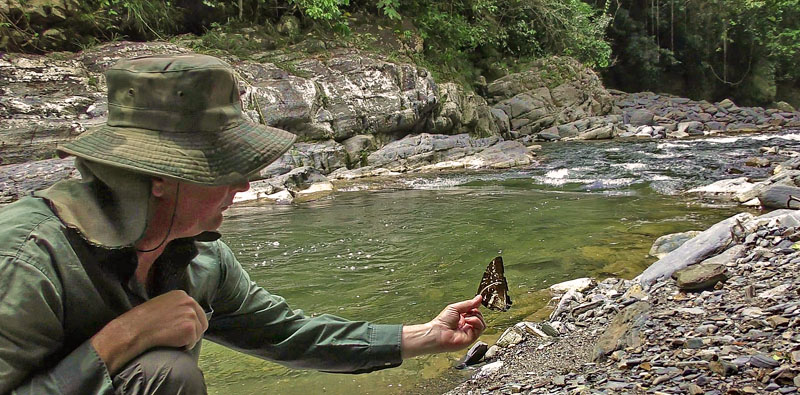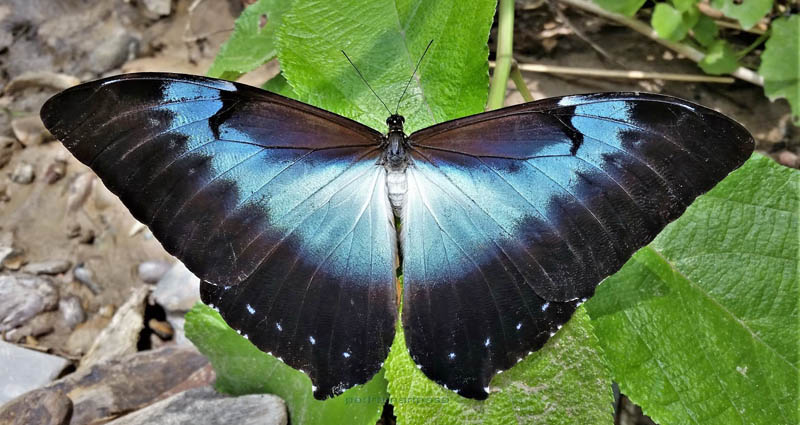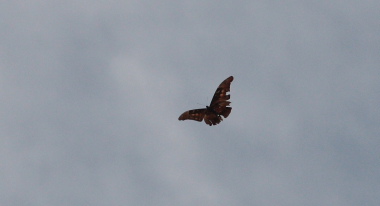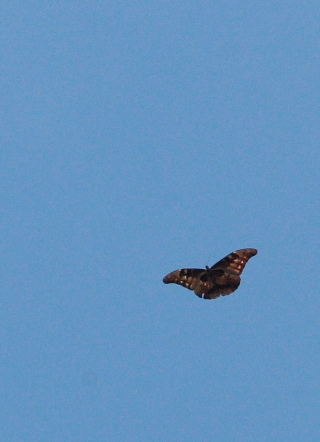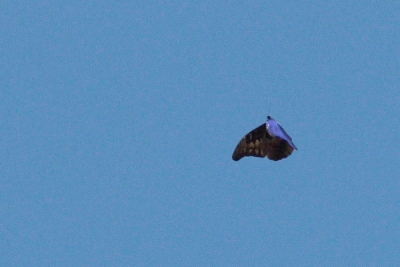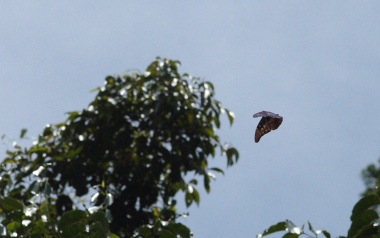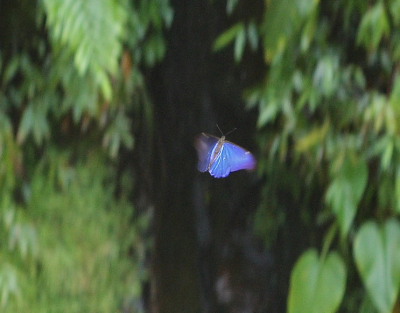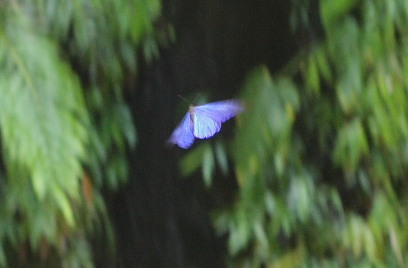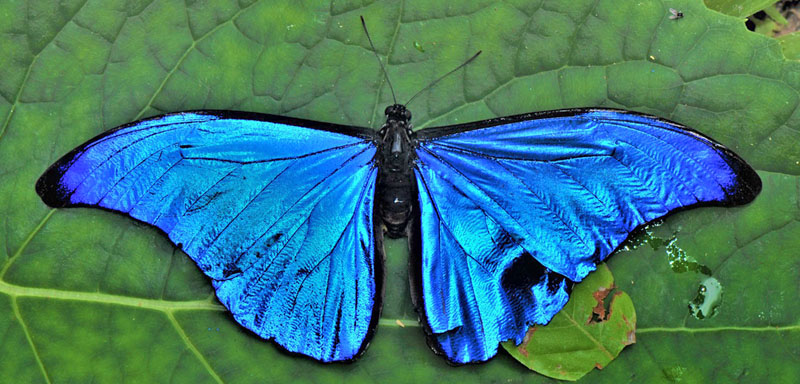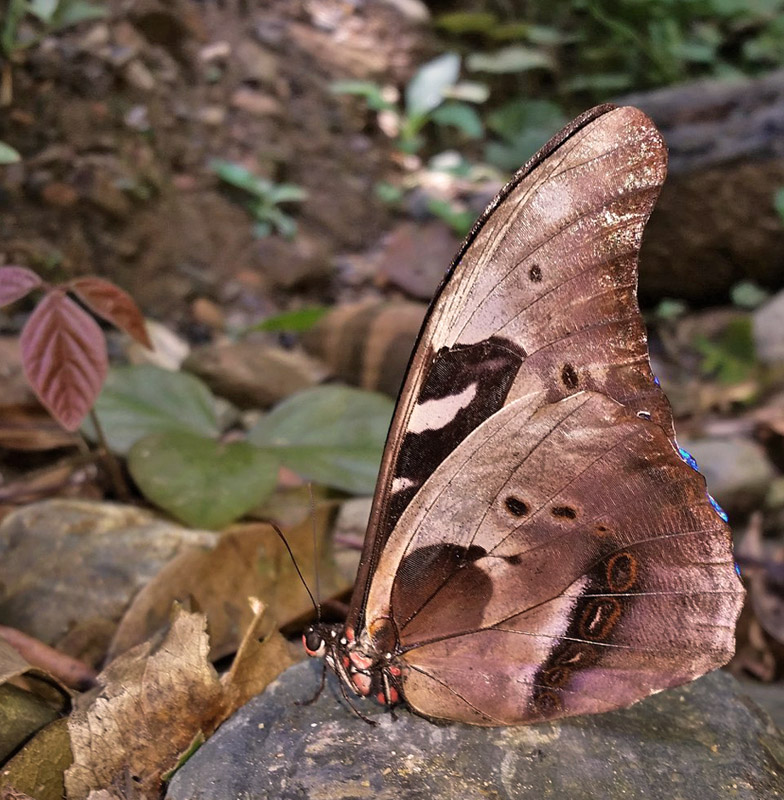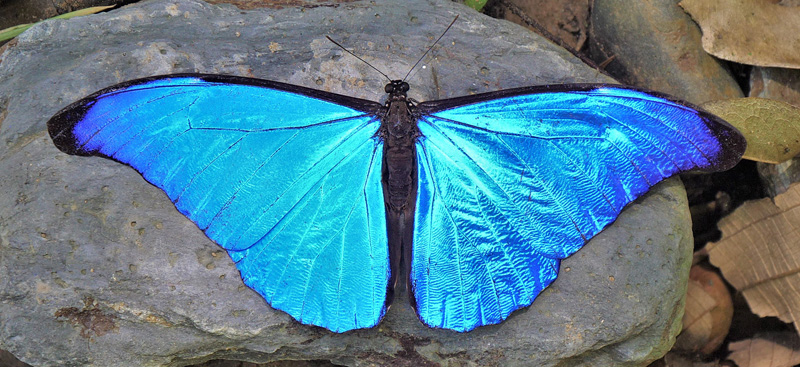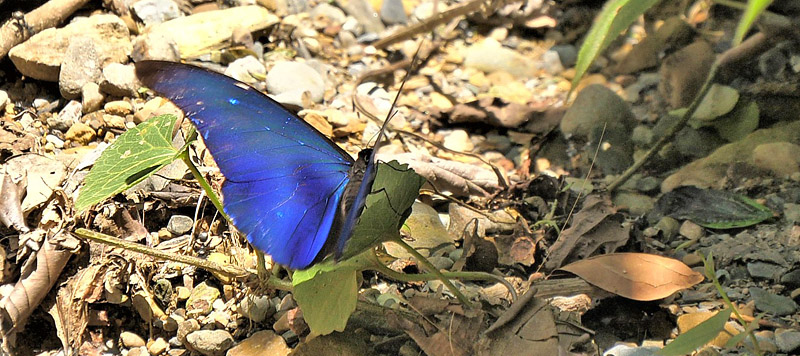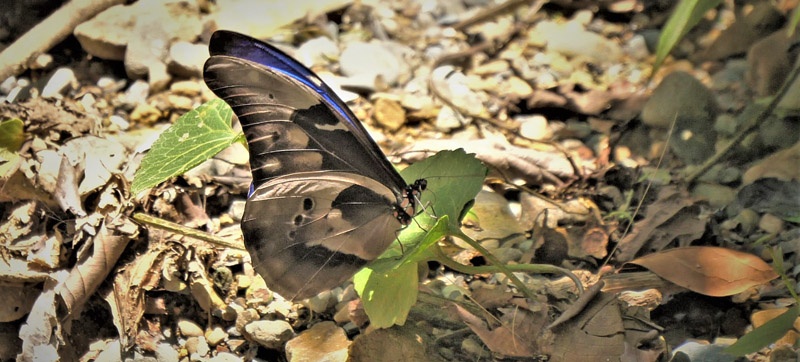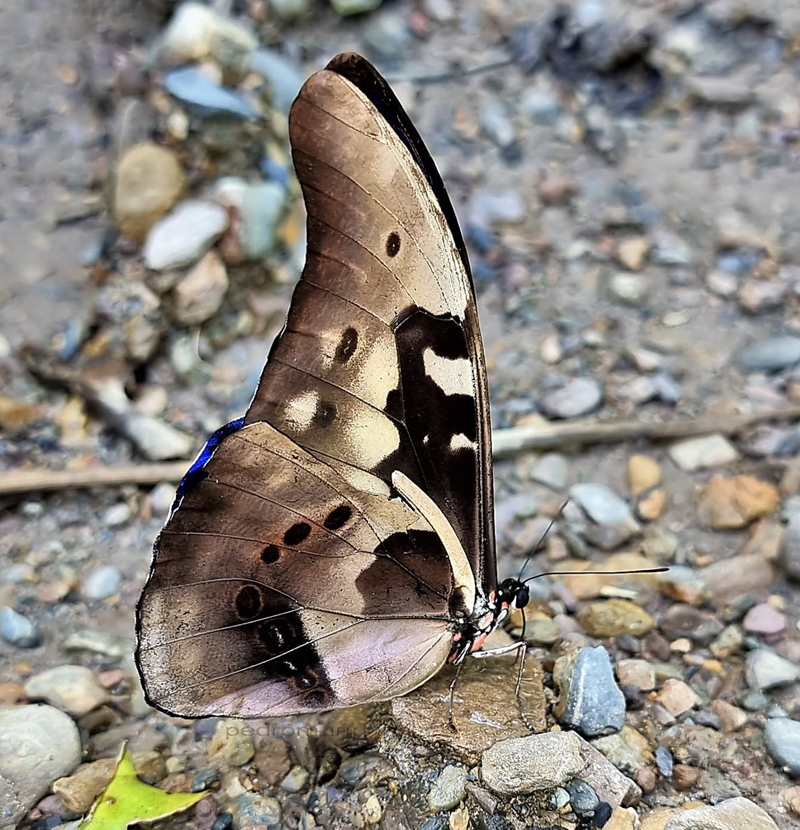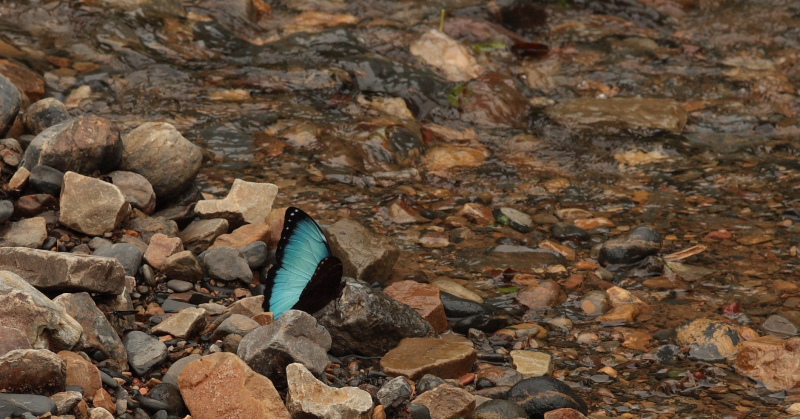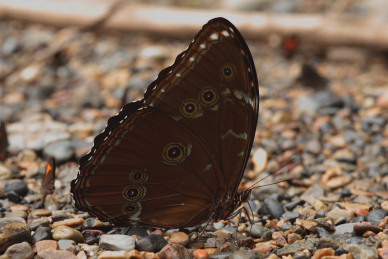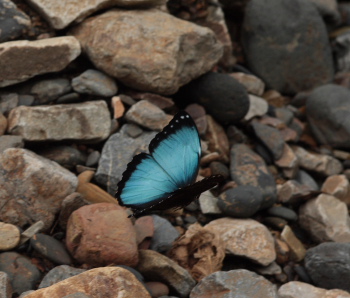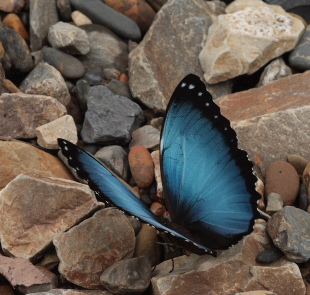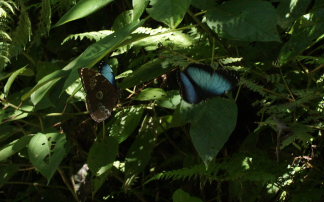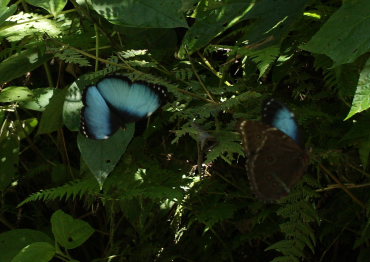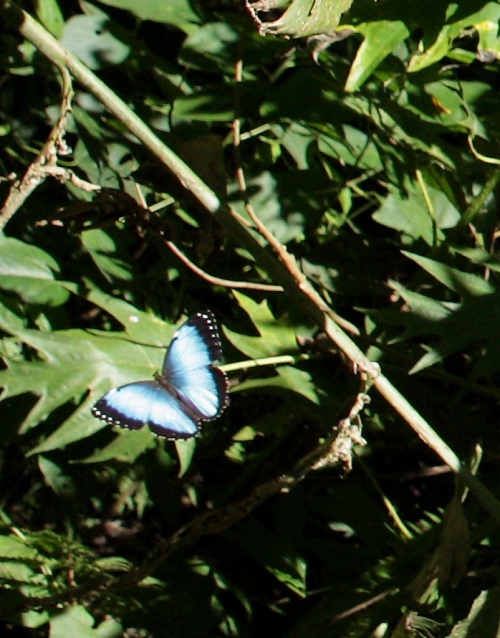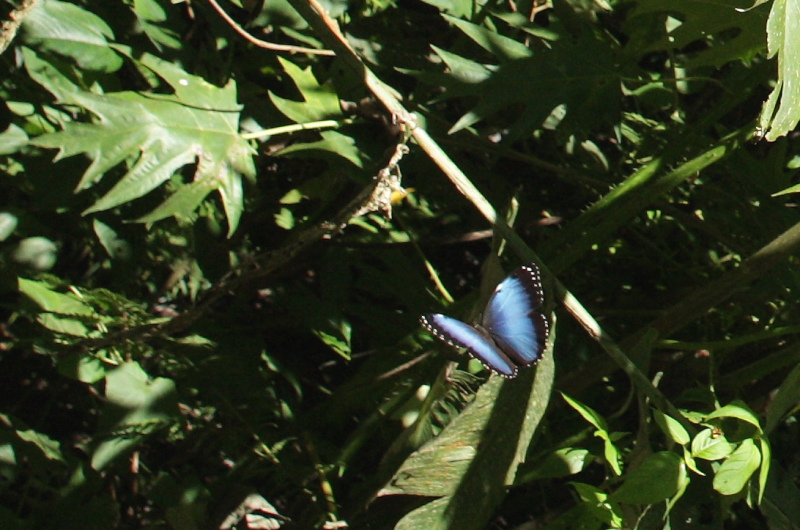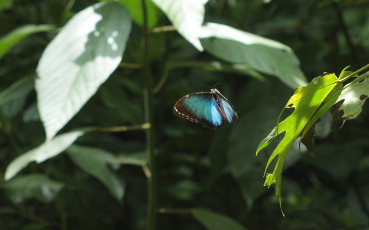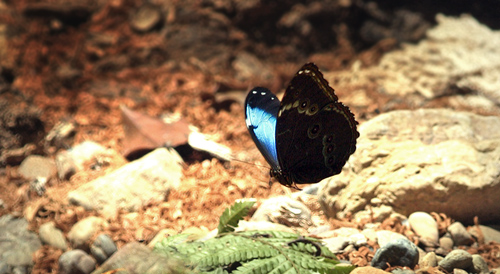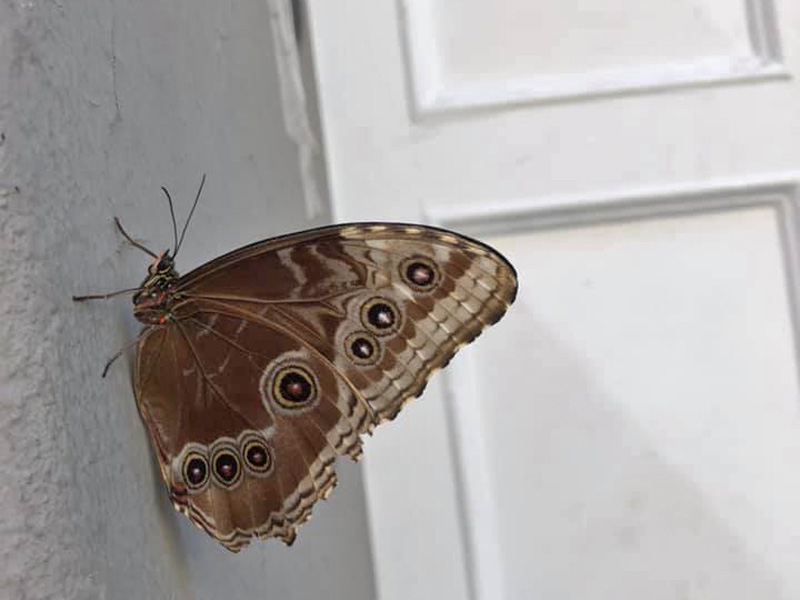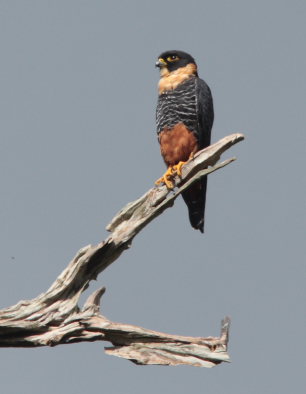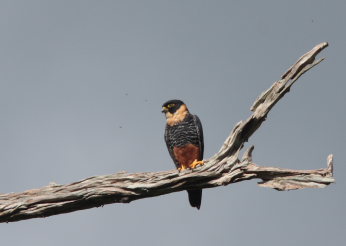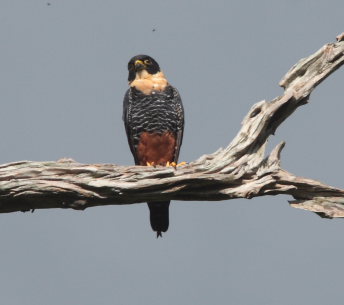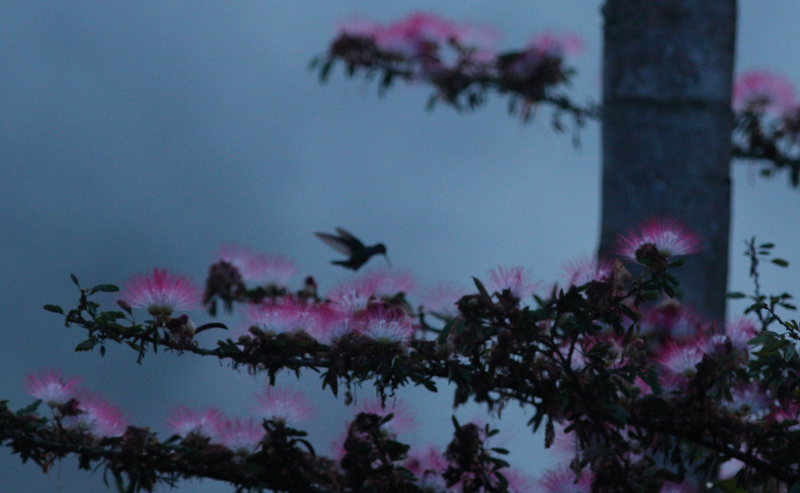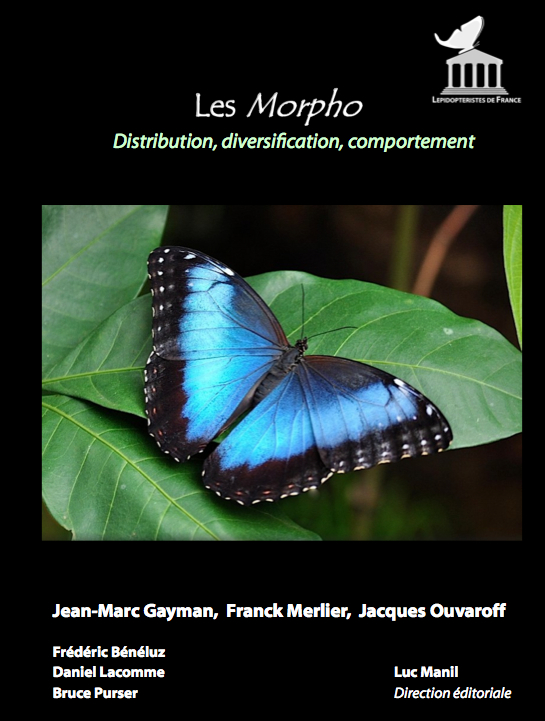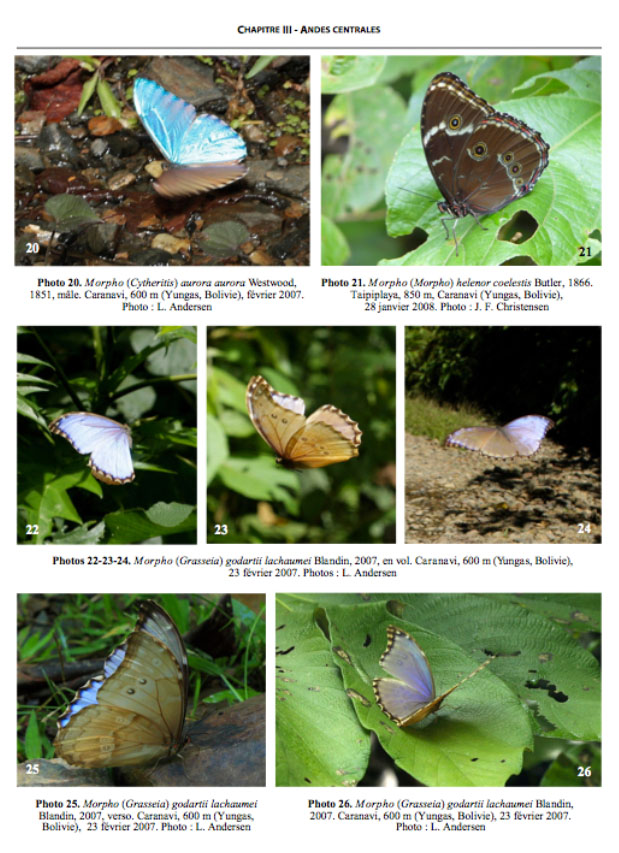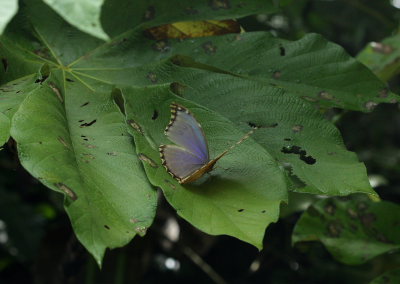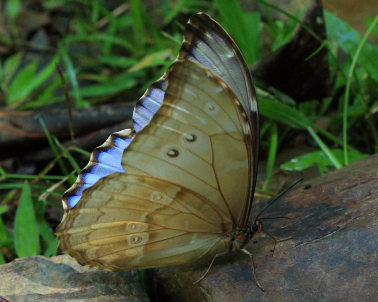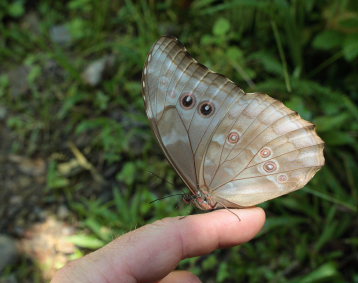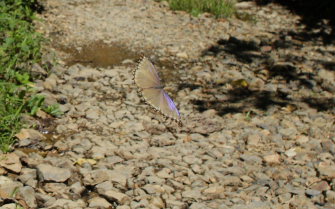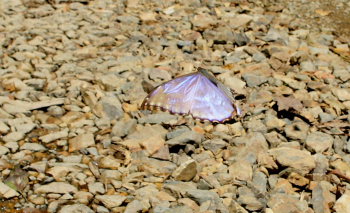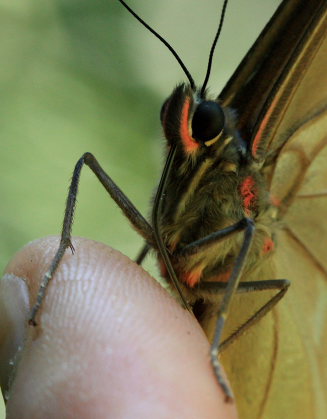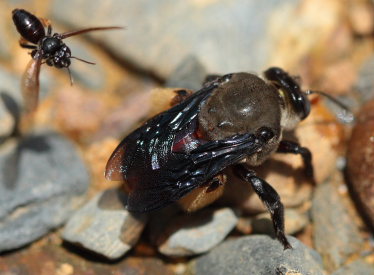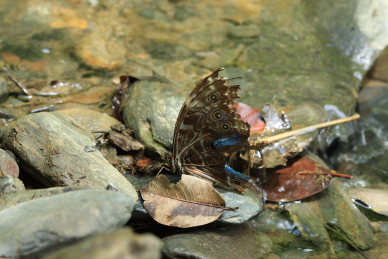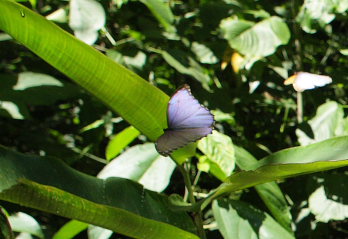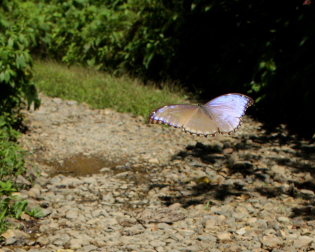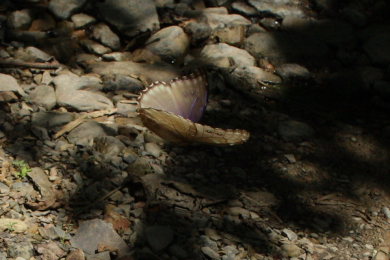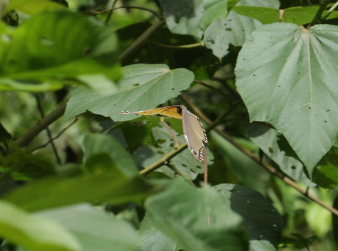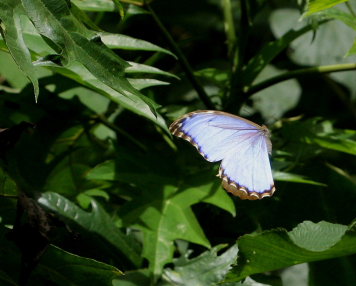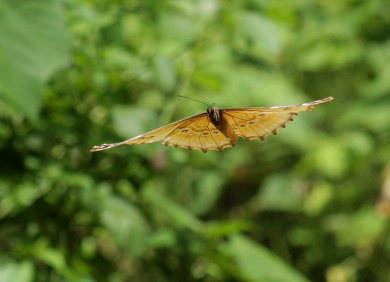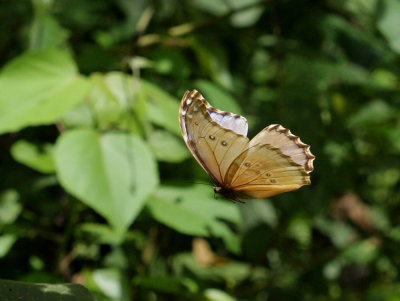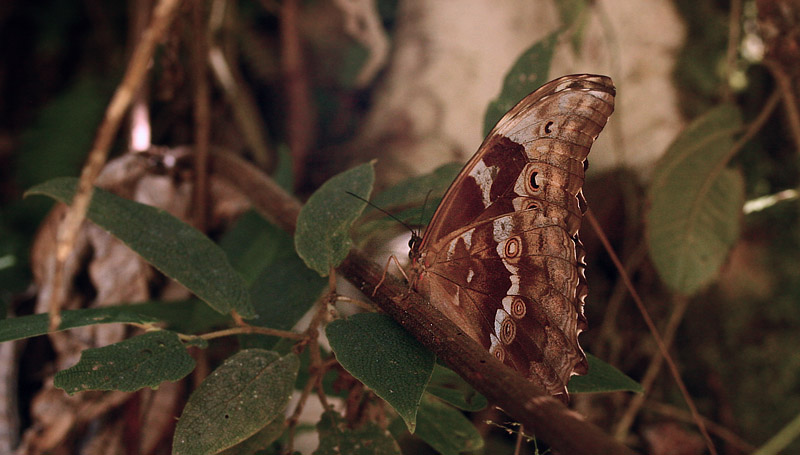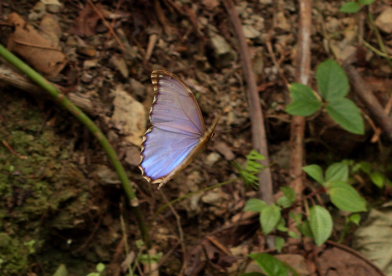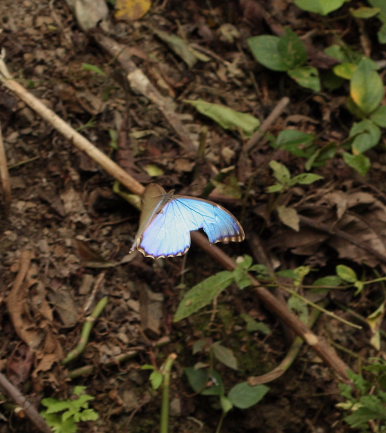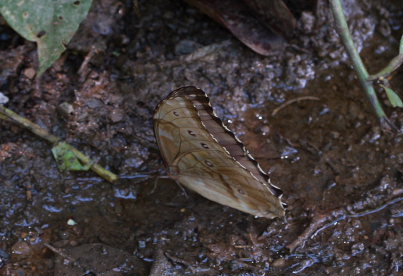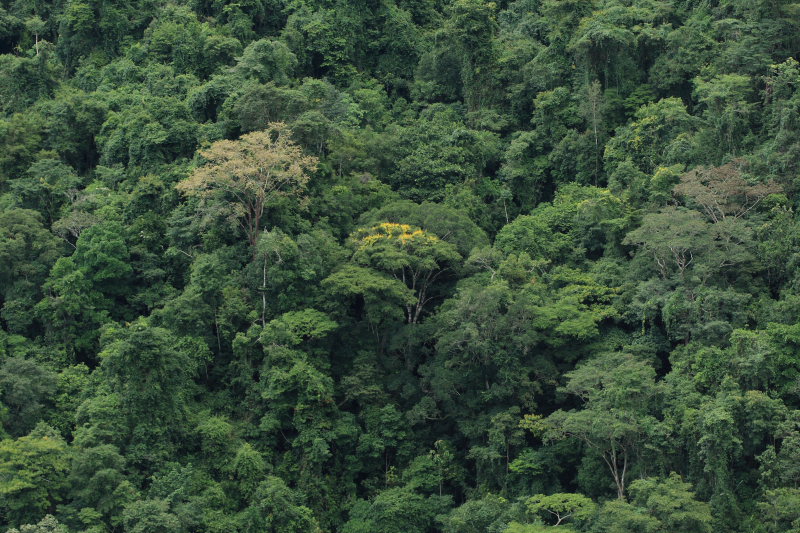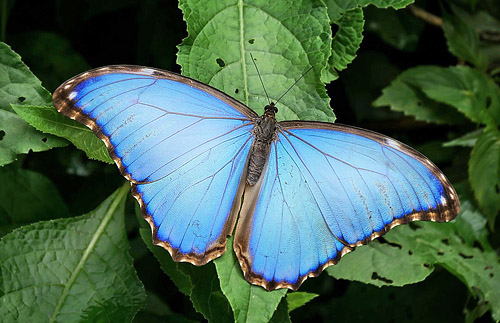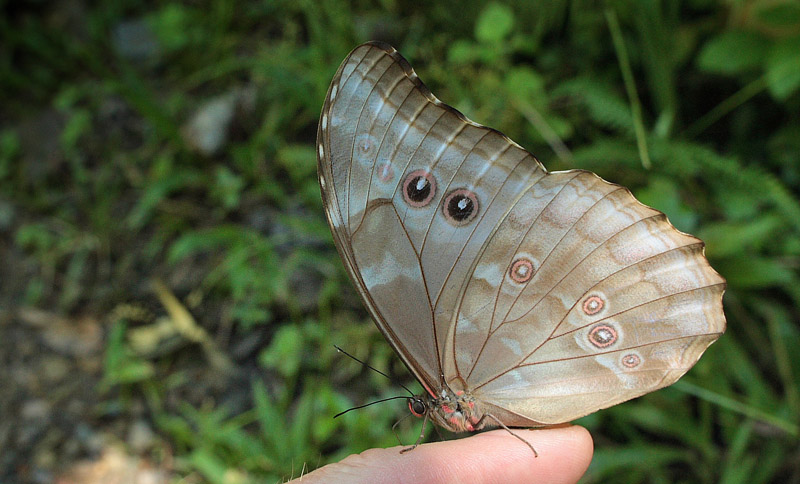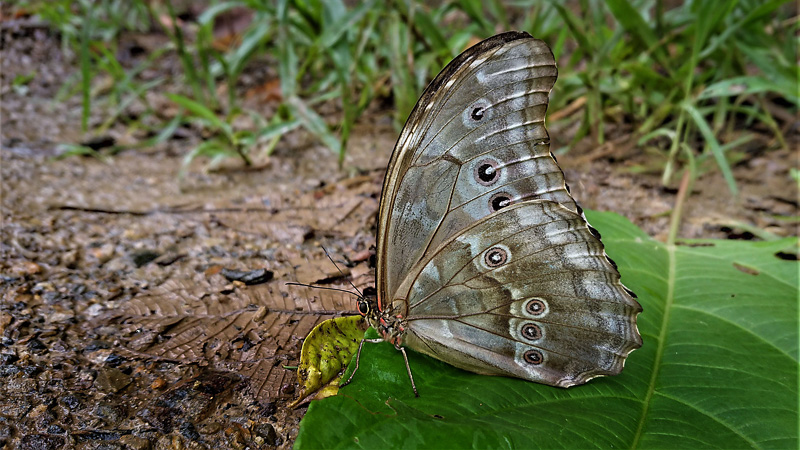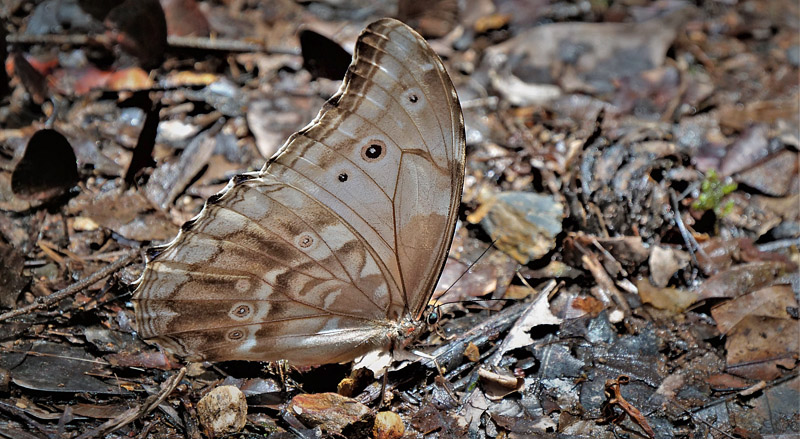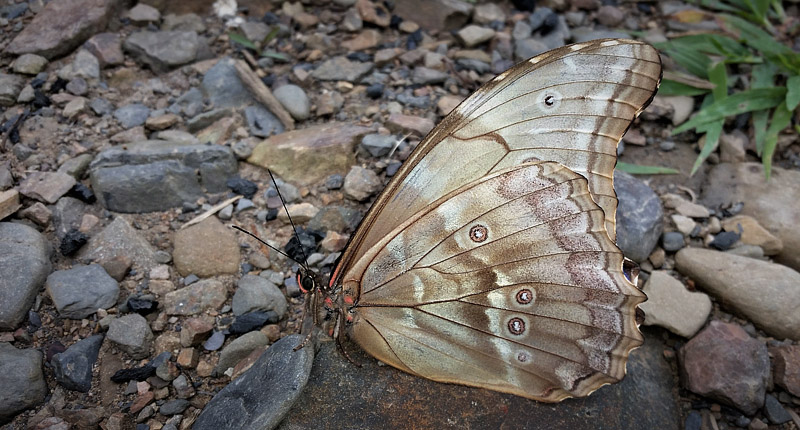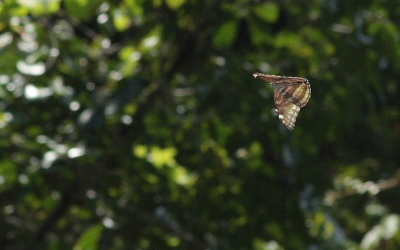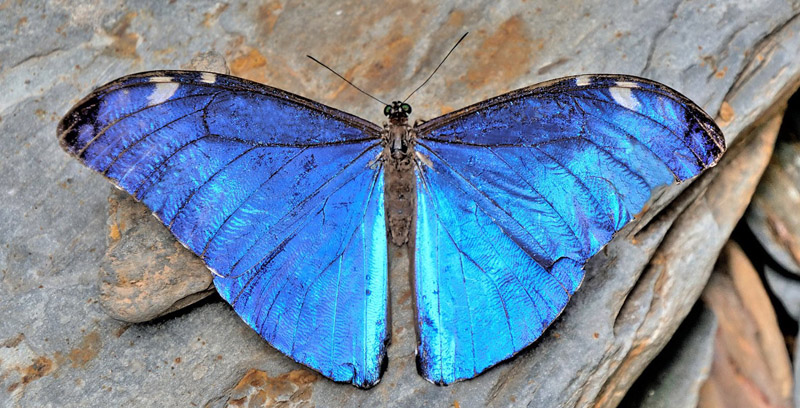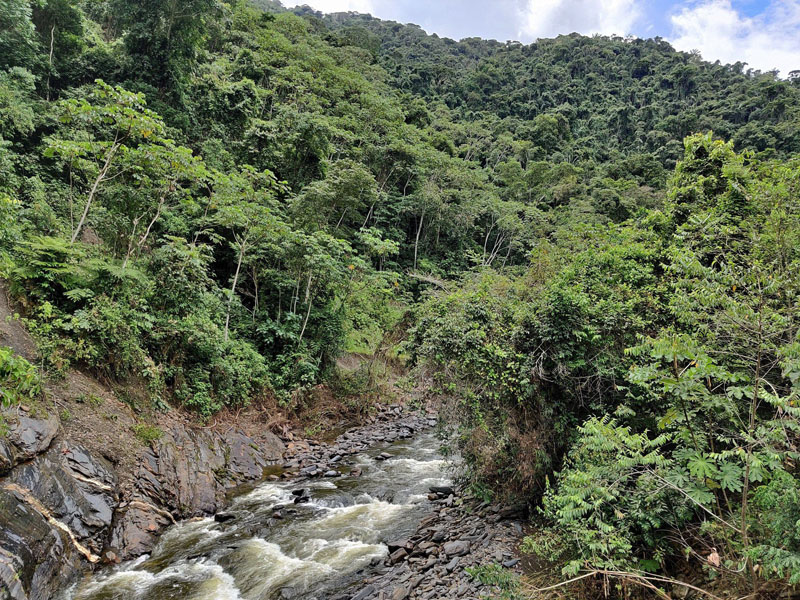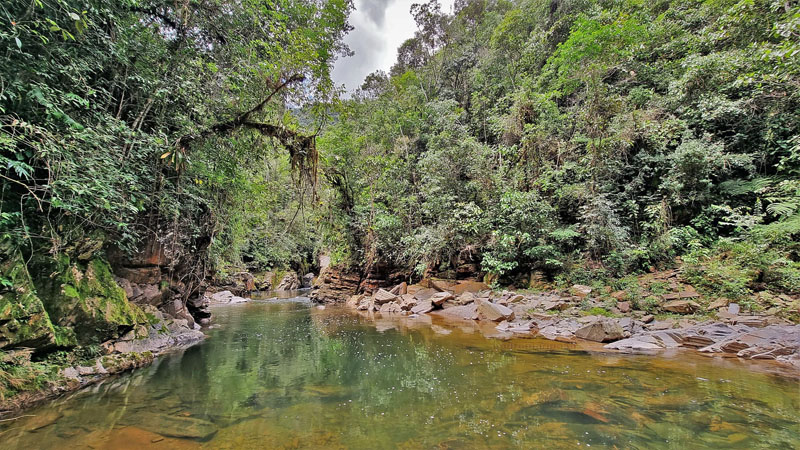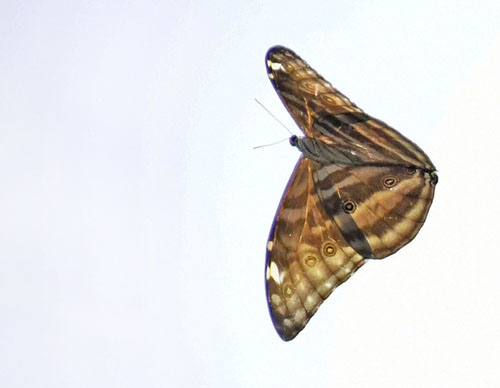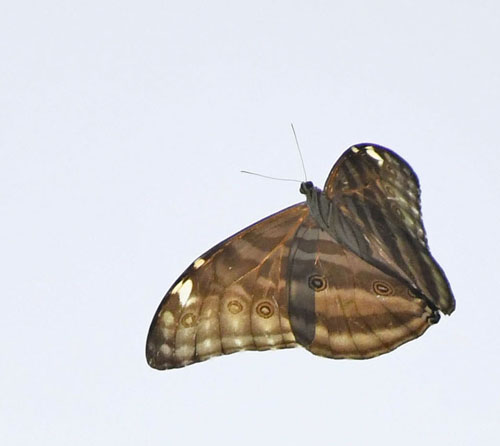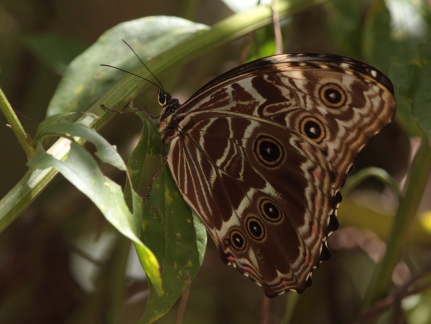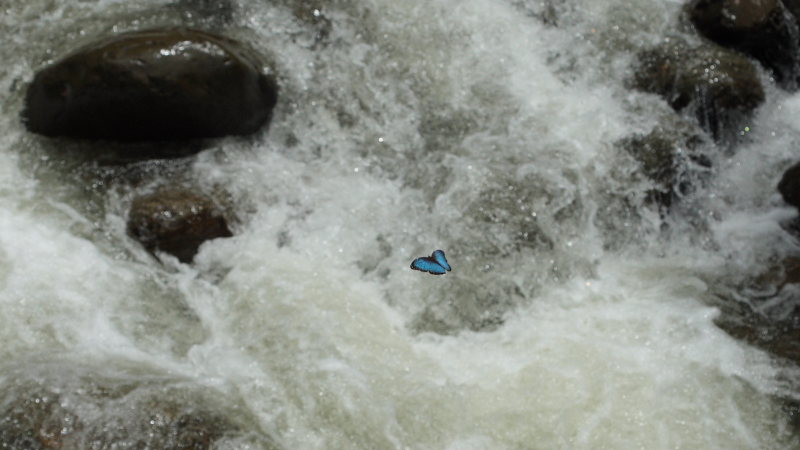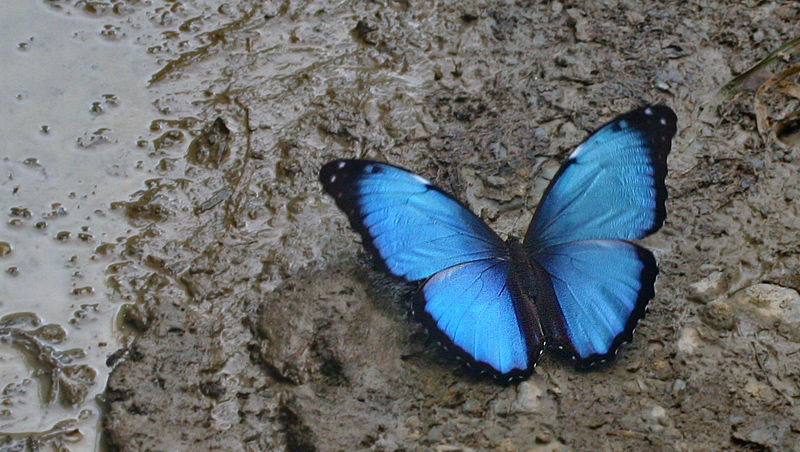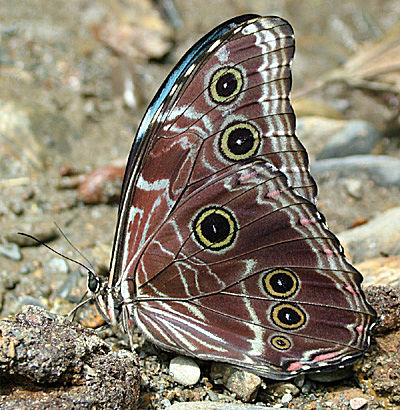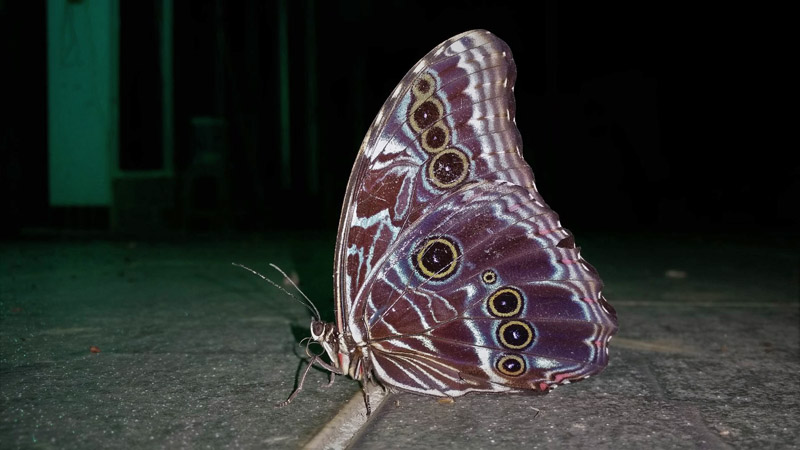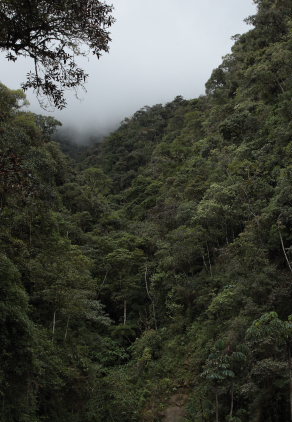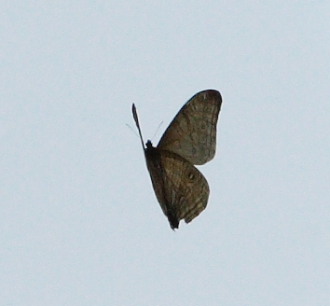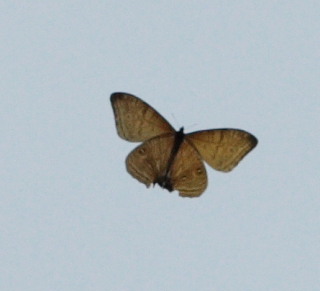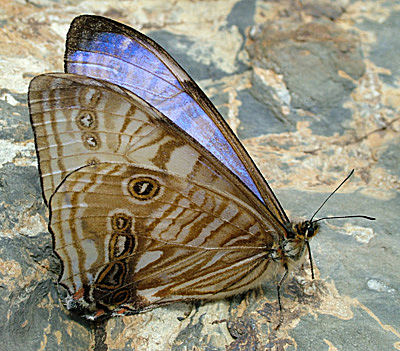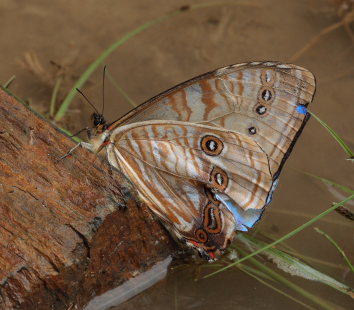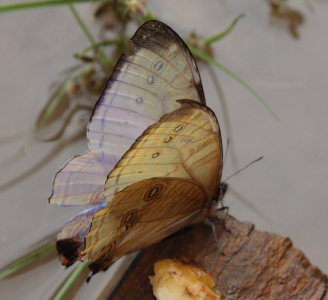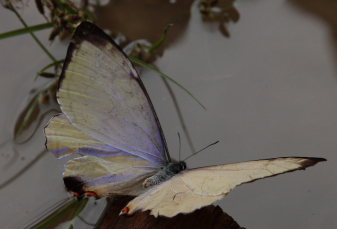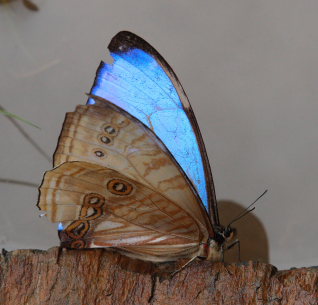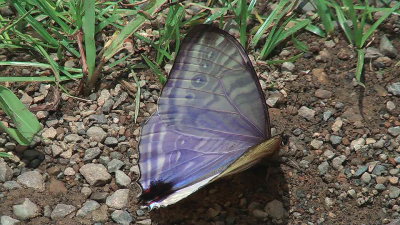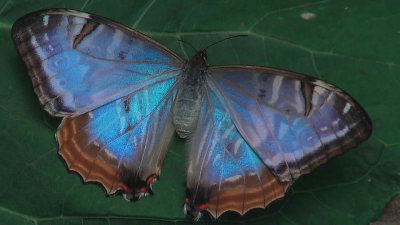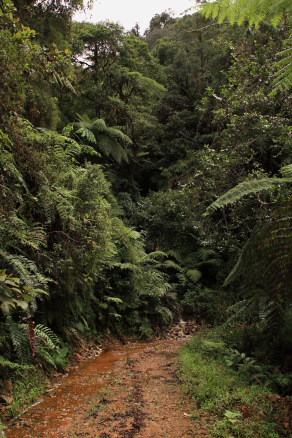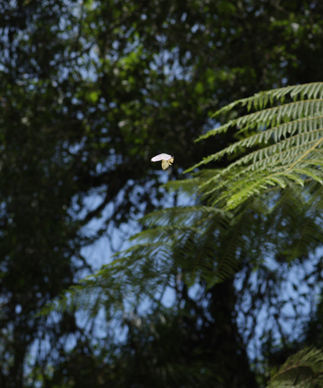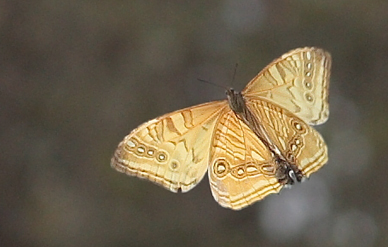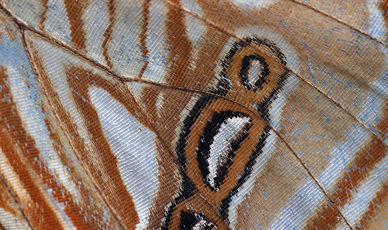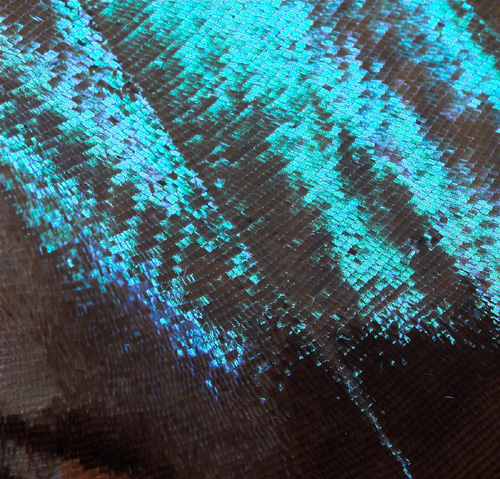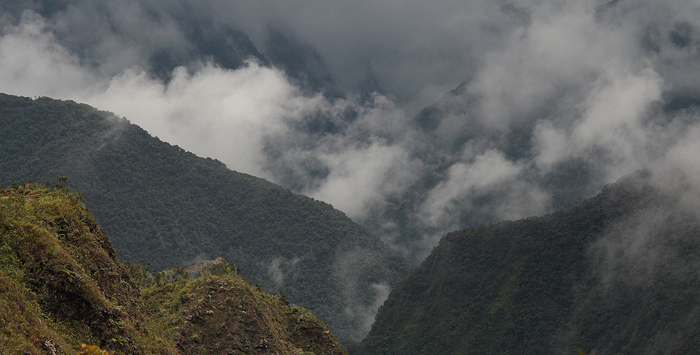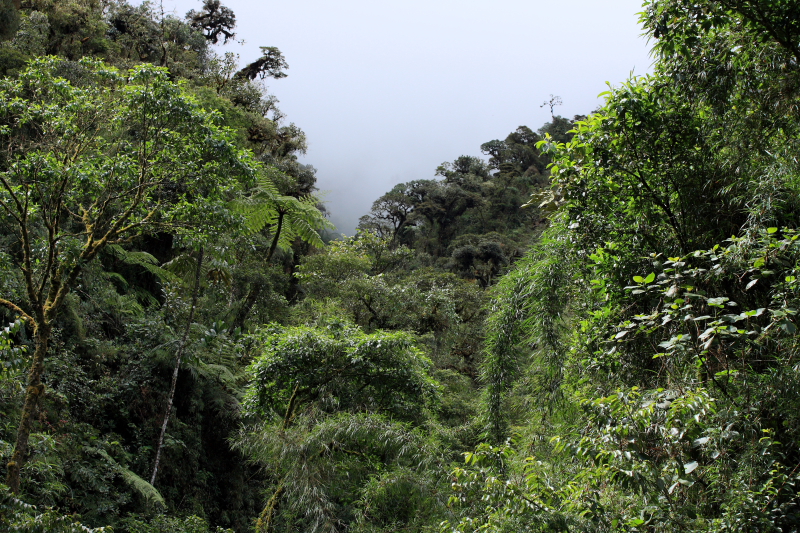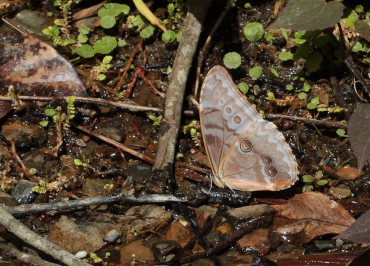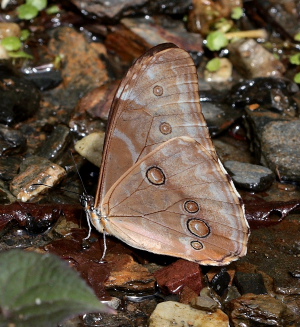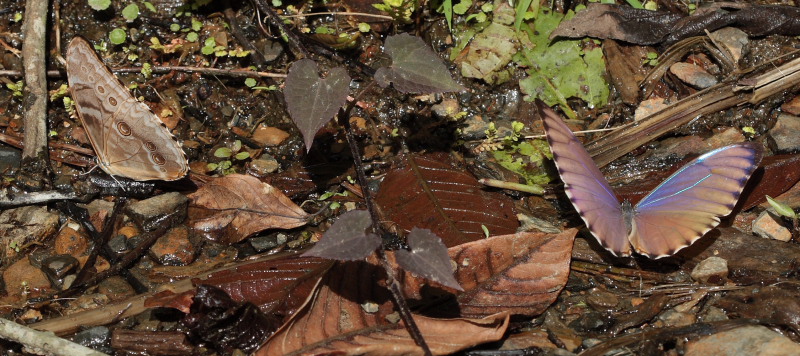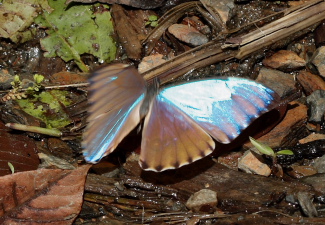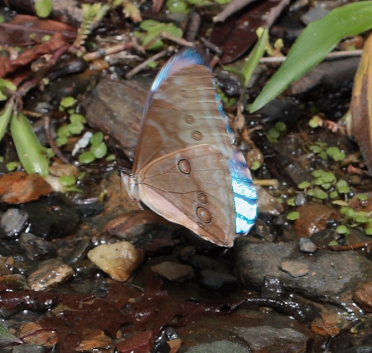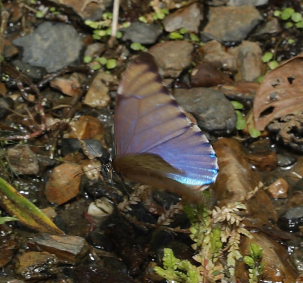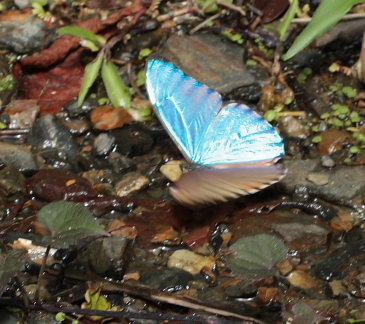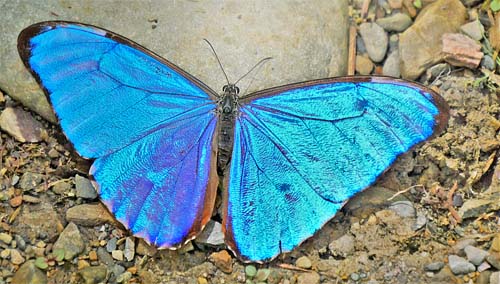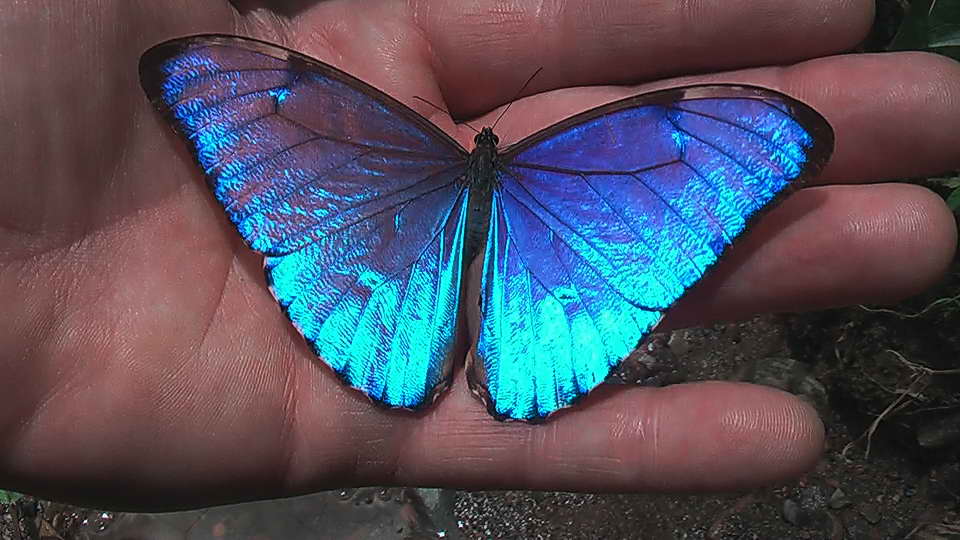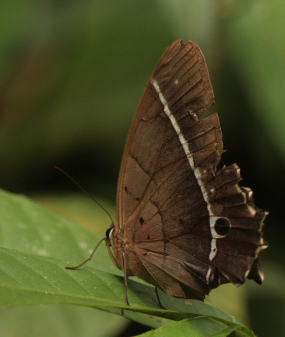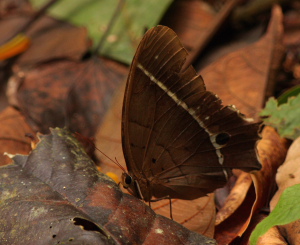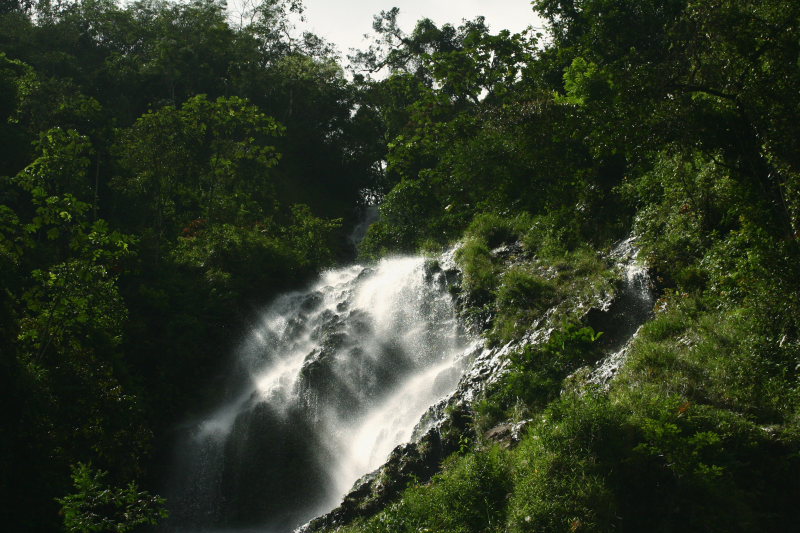Mariposas de Bolivia
Morphos / Tornesol, Morphinae
sitio 54
Enero - Febrero 2005 to 2022
first update d. 16 march 2009
last update d. 27 march 2025
_____________________________
Morpho telemachus ssp. exsusarion
Grey
Morpho, Morpho telemachus ssp. exsusarion
(Le Moult
& Réal, 1962).
Pusiliani, Caranavi,
Yungas, Bolivia January 12, 2010. Photographer; Lars Andersen
Grey Morpho, Morpho telemachus ssp. exsusarion (Le Moult & Réal, 1962). |
Quijarro, Caranavi, Yungas, Bolivia January 20, 2016. Photographer; Peter Møllmann |
Morpho
telemachus ssp. exsusarion (Le Moult &
Réal, 1962).
Pusiliani, Caranavi, Yungas, Bolivia december 9, 2017. Photographer; Peter Møllmann
Grey Morpho, Morpho telemachus ssp. exsusarion (Le Moult & Réal, 1962) en copula. Caranavi Highlands, Yungas, Bolivia january 15, 2019. Photographer; Peter Møllmann
Morpho telemachus ssp. exsusarion (Le Moult & Réal, 1962). Caranavi Highlands, Yungas, Bolivia november 24, 2021 Photographer; Peter Møllmann
_____________________________
Morpho amphitryon ssp. susarion
Morpho amphitryon ssp. susarion (Fruhstorfer, 1913). Caranavi, Yungas, Bolivia february 1, 2006. Photographer; Lars Andersen
Morpho amphitryon ssp. susarion (Fruhstorfer, 1913). Caranavi, Yungas, Bolivia december 2014. Photographer; Peter Møllmann
Amphitryon Morpho, Morpho amphitryon ssp. susarion (Fruhstorfer, 1913). |
Copacabana, Caranavi, Yungas, Bolivia January 23, 2016. Photographer; Peter Møllmann |
Amphitryon
Morpho, Morpho
amphitryon ssp.
susarion
(Fruhstorfer,
1913).
Ecovia,
Coroico, Yungas, Bolivia december 17, 2017. Photographer; Peter Møllmann
_____________________________
Morpho amphitryon in slow motion
by Peter Møllmann
17th december 2017
Amphitryon
Morpho, Morpho
amphitryon ssp.
susarion
(Fruhstorfer,
1913).
Ecovia,
Coroico, Yungas, Bolivia december 17, 2017. Photographer; Peter Møllmann
_____________________________
Morpho cisseis ssp. cisseistricta
Morpho cisseis. Rio Zongo, Yungas, Bolivia January,2009 & 2010. Photographer; Lars Andersen
Cisseis Morpho, Morpho cisseis . Caranavi, elev. 1000 m. Yungas, Bolivia anuary 10, 2014. Photographer: Ole Andersen
| Peter Møllmann have captured one of the largest butterflies flying around in Bolivia: |
| Cisseis Morpho, Morpho cisseis ssp. cisseistricta (Le Moult & Réal, 1962). |
| Pusiliani, Caranavi, Yungas, Bolivia January 16, 2016. Photographer; David Norfleet |
Morpho cisseis ssp. cisseistrica (Le Moult & Réal, 1962).
Rio Broncini 585 m.,
Caranavi Valley, Yungas, Bolivia February 21, 2022. Photographer; Peter Møllmann
_____________________________
Morpho rhetenor (Cramer, 1775)
| Sickle-winged Morpho, Morpho rhetenor (Cramer, 1775). |
| Caranavi. Yungas, Bolivia january 2009-10. Photographer; Lars Andersen |
Sickle-winged Morpho, Morpho rhetenor (Cramer, 1775). Provincia Caranavi, Yungas, Bolivia d. 7 january 2020. Photographer; Nikolaj Kleissl
Sickle-winged Morpho, Morpho rhetenor (Cramer, 1775). Provincia Caranavi, Yungas, Bolivia d. 19 january 2018. Photographer; Peter Møllmann
| Sickle-winged
Morpho, Morpho
rhetenor
(Cramer, 1775). This blue morpho is the super animal among butterflies, a concorde among the flying butterflies in the ravines and river valleys of the tropical forest. Its top is amazing metallic shiny blue and flashes in the sun so it hurts the eyes. I myself Lars Andersen saw it back on January 29, 2010 in the Caranavi Valley, Yungas, Bolivia. And I will never forget that sight. Distribution: found in Guyana, Suriname, French Guiana, Brazil, northern Paraguay, Bolivia, Peru, Ecuador, Colombia and Venezuela around the Amazon Basin up to 800 meters altitude on the eastern slopes of the Andes. Host plant: The larva lives on Macrolobium bifolium, the Fabaceae family. Morpho rhetenor ssp. rhetenor (Cramer, 1775) TL: Surinam M T S Morpho rhetenor ssp. cacica (Staudinger, 1876) TL: Peru M T Morpho rhetenor ssp. columbianus (E. Krüger, 1925) TL: Colombia M T1 T2 Morpho rhetenor ssp. equatenor (Le Moult & Réal, 1962) TL: Ecuador M T Morpho rhetenor ssp. hightoni (Neild, 2008) TL: Venezuela Morpho rhetenor ssp. helena (Staudinger, 1890) TL: Peru M T Morpho rhetenor ssp. subtusmurina (Le Moult & Réal, 1962) TL: Brazil (MT) M T In
Bolivia it is: GBIF: Global Biodiversity
Information Facility. |
Sickle-winged Morpho, Morpho rhetenor (Cramer, 1775). Provincia Caranavi, Yungas, Bolivia d. 19 january 2018. Photographer; Peter Møllmann
Sickle-winged Morpho, Morpho
rhetenor (Cramer, 1775).
Rio Broncini,
Caranavi Valley 628m., Yungas, Bolivia January 3, 2022. Photographer; Peter Møllmann
I saw 7 rhetenores today, one came down to my bait.
Got some slo mo also.
with samsung 21ultra. 240 fps. Copyright pedromariposa.
_____________________________
Morpho achilles ssp. songo (Weber, 1944).
| Achilles Blue Morpho or Banded Blue Morpho, Morpho achilles ssp. songo (Weber, 1944). |
| Coroico to Caranavi elevation 600 - 1800 m. Yungas, Bolivia january - february 2005-12. |
| Photographer; Lars Andersen |
| Achilles Blue Morpho, Morpho achilles ssp. vitrea hunting a Common Blue Morpho, Morpho helenor ssp. coelestis. |
| Coroico to Caranavi elevation 600 - 1800 m. Yungas, Bolivia january - february 2005-12. Photographer; Lars Andersen |
___________________
Morpho achilles songo in slow motion
by Peter Møllmann
Februay 2018
Achilles Blue Morpho or Banded Blue Morpho, Morpho achilles ssp. songo (Weber, 1944).
From Caranavi Bolivia february 2018. Made with sony
experia xz premium. Photographer; Peter Møllmann
_____________________________
Morpho helenor ssp. coelestis (A. Butler, 1866).
| Common Blue Morpho, Morpho helenor ssp. coelestis (A. Butler, 1866). |
| Coroico to Caranavi elevation 600 - 1800 m. Yungas, Bolivia january - february 2005-12. Photographer; Lars Andersen |
Common Blue Morpho, Morpho helenor ssp. coelestis. Caranavi elevation 1000 m. Yungas 21 january 2012. Photographer; Lars Andersen
| Common
Blue Morpho,
Morpho helenor (Cramer, 1776). Introduction: Description: Andrew Neild ( author of Butterflies of Venezuela) describes the differences between Morpho helenor and M. achilles thus: "In helenor the submarginal whitish band on the underside hindwing widens towards the apex and is usually widest at the apex in achilles it narrows towards the apex, and is usually wider / widest in its mid section. Also, but not always, on the FW, in space 3 (the one that usually has the biggest FW ocellus), the broad pale band is almost always crescent-shaped. In achilles it is usually triangular, or if nearly crescent-shaped, wider than it is in sympatric helenor". Wingspan: 100-120mm. Habitats: This species is found in terrace forests along rivers in the lowlands to wet tropical forests and small farms along the river valleys of the smaller mountains up to Andean cloudforest at altitudes of up to about 1800m in Coroico valley. Flightseason: In Bolivia from november to february. Foodplants: Palo de
hoz, Machaerium
lunatum
(Fabaceae). Machaerium
lunatum
varies in habit from an evergreen shrub to small
tree growing up to 5 metres tall, to a climbing
shrub producing cylindrical stems up to 15 metres
long and 12cm in diameter that climb into the
surrounding vegetation. And other foodplants are Peanut, Arachis hypogaea (Fabaceae). Parivo'a, Macrolobium bifolium (Fabaceae) and Coinvine, Dalbergia ecastaphyllum (Fabaceae) and Ice Cream Beans, Inga edulis (Mimosaceae). When you open Ice Cream bellows are the beans in a white fluff. Are a delicacy when you are feel a little hungry in the forest and tastes like ice cream. Distribution, local in Bolivia; Andean foothills. Buena Vista, Villa Tunari (Cochabamba), Rio Beni basin to Caranavi and Coroico valley. And Bolivian lowland (Santa Cruz. Brazil; Cuiabá, Mato Grosso. Distribution:
Found throughout Central and South America from
Mexico to Argentina to southern Mexico. Morpho
helenor
ssp. theodorus (Fruhstorfer 1907),
lives in Amazonian moist tropical rainforests in
western and northern Bolivia. GBIF: Global Biodiversity
Information Facility. íNaturalist.org Link to facebookgroup about Morpho helenor ssp. prometa |
_____________________________
Morpho helenor ssp. peleides (Kollar, 1850).
Common Blue Morpho, Morpho helenor ssp. peleides. Botanical Garden, Copenhagen, Northzealand d. 9 august 2020. Fotographer; Thomas Toby Ekman
| A neotropic species that has escaped from the Zoo or Botanical Garden tropical house in Copenhagen? |
_____________________________
Bat Falcon, Falco rufigularis. Rio Zongo, Caranavi, Yungas, Bolivia january 31, 2009. Photographer; Lars Andersen
| The Bat Falcon, Falco rufigularis has a wide distribution throughout the lowland Americas. It is one of the smallest falcons. And as its name suggests, its diet contains a significant number of bats, which are more hunted by the larger females. Famed naturalist William Beebe watched a nesting pair over 164 days, and witnessed a wide diversity of prey, from warblers and tanagers to a blue morpho butterfly. |
A Hummingbird and Flowering Ice Cream Beans, Inga edulis. Caranavi, Yungas 13 February 2009. Photographer: Lars Andersen
| The blue Morphos (Morphini) is the most famous
butterflies from South America, often large up to
20 cm. in wingspan when Morpho
hecuba
is the largest butterflies in the neotropical
continent. There are also Morphos down to 7.5 cm
in size of M. sulkowskyi & M.
aurora,
small species typically found in higher altitudes
of the Andes east slopes. Most species have an iridescent blue color on top. The blue color on the upper side due to refraction of light in the delicate tight scales which lack color pigment scales sits right advanced so they can display the entire color scale in a few moments when the light is broken at the right angle. The underside is often in brown shades, bearing Eyed in various sizes that reveal their family connection to Satyr family (Satyrinae). There are also white Morphos; (M. epistrophus & M. polyphemus) and Morphos; brown with gray or orange bands on the upper side (M. Hecuba & M. Telemachus). The origin of Morphinae dates back about 55 MY and occurred in the Brazilian Shield (Mata Atlantica), the oldest part of Sout America that emerged. Considering the length of the evolutionary period, the number of species of Morpho (30) proves quite limited, especially if one considers the immense size of their geographical distribution. This small number contrast with the considerable number of subspecies: at last 220. The single species Morpho helenor has branched out into 48 subspecies spread from Tamaulipas, Mexico's east coast, Central America, Amazonian basin to northern Argentina. The diversity of subspecies is due, to a large extent, to the fact that Morpho are not migratory? De blå Morphoer (Morphini), er de mest kendte dagsommerfugle fra Sydamerika, ofte store op til 20 cm. i vingefang, hvor Morpho hecuba er den største dagsommerfugl i den neotropiske verdensdel. Der findes også morphoer helt ned til 7,5 cm i størrelse, hvor M. lympharis & M. aurora er de små arter som typisk findes i større højder på Andesbjergenes østlige skråninger. De fleste arter har et iriserende blå farve på oversiden. Den blå farve på oversiden skyldes brydning af lyset i de fine tætsiddende skæl som mangler farve pigment, skællene sidder ret avanceret så de kan vise hele farve-skalaen i nogle få øjeblikke når lyset brydes i den rette vinkel. Undersiden som ofte er i brune nuancer, er forsynet med øjepletter i forskellige størrelser, der afslører deres slægtsforbindelse til randøjerne (satyrinae). Der findes også hvide morphoer (M. epistrophus, M. polyphemus) og brune morphoer med grå eller orange bånd på oversiden (M. hecuba, M. telemachus). Oprindelsen af Morphinae går tilbage til omkring for 55 milioner år siden, og fandt sted på den brasilianske kontinentalplade (Mata Atlantica), den ældste del af Sydamerika der er opstået føt pladerne fra vest pressede sig under, og dermed opstod Andesbjergene. I betragtning af længden af den evolutionære periode, antallet af arter af Morpho (30) som er ret begrænset, især hvis man betragter den enorme størrelse af deres geografiske udbredelse. Men det er tankevækkende det lille antal arter kontrast de mange underarter, ialt 22o underarter. F.eks. har Morpho helenor hele 48 underarter udbredt fra Tamaulipas, Mexico østkyst, Mellemamerika, Amazonas til Andesbjergene i det centrale Sydamerika til nordlig Argentina. __________________________________________________________ In Bolivia, I have seen 13 species of 45 species Morphini genus contained in the neotropiske region: Antirrhea (13) Caerois (2) Morpho (30). Their distribution is from Mexico north to Misiones, Argentina in the south. Link to Morphini genus of Bolivian Butterflies Checklist. Bolivian Morphini species: Antirrhea (6) Caerois (1) Morpho (17)
I Bolivia har jeg set 12 arter af de 45 arter Morphini genus der findes i den neotropiske region: Antirrhea (13), Caerois (2), Morpho (30). Deres udbredelse er fra Mexico i nord til Misiones, Argentina i syd. Link til Morphini genus på Bolivian Butterflies Checklist. Reference to: Les Morpho 14th october 2016 Les Morpho: Distribution, diversification,
behavior |
_____________________________
Morpho godartii ssp. godartii
| Giant Light-blue Morpho, Morpho godartii ssp. godartii (Guérin-Méneville, 1844).. |
| Caranavi, Yungas, Bolivia january - february 2007- 10. Photographer; Lars Andersen |
The
beautiful blue Morphos males are often
seen along rivers and small streams, where they
fly searching for ladies and is territorale and
chasing other males away. Morphos go to rotten
fruit and suck minerals in sandy banks along
streams. Females live a more covert lives up the
leaves, and are rarely seen. Morphos habitat is
the rain-forests of the tropical zone, however
individual species such as Morpho sulkowskyi
existence from 2000 m.a. up to 2900 m. altitude in
fog-forests in the Andes eastern slopes.
De flotte blå Morpho hanner ses ofte langs floder og små vandløb, hvor de flyver søgende efter damer og er territorale og jagter andre hanner væk. Morphoerne går til råddent frugt og suger mineraler på sandbanker langs vandløb. Hunnerne lever en mere skjult tilværelse oppe i løvet, og ses sjældent. Morpho'ernes habitat er regnskovene i den tropiske zone, der er dog enkelte arter som Morpho sulkowskyi der findes fra 2000 m. op til 2900 m.h. i tågeskovene på Andesbjergenes østskråninger. Morpho godartii ssp. godartii
Morpho godartii ssp. titogilberti
Giant Light-blue Morpho, Morpho
godartii
ssp. titogilberti (Blandin
& Gareca, 2011) male. Morpho godartii ssp. lachaumei Giant Light-blue Morpho, Morpho
menelaus ssp. godartii f.
lachaumei
(Blandin, 2007) male. Giant Light-blue Morpho, Morpho
godartii ssp. achaumei
(Blandin, 2007) male. ____ Morpho godartii ssp. godartii male Giant Light-blue Morpho, Morpho
godarti ssp. godartii
ssp. lachaumei (Blandin,
2007) male. Giant Light-blue Morpho, Morpho
godartii ssp. lachaumei
(Blandin, 2007). _____________________________ Morpho marcus ssp. intermedia
Adonis Morpho, Morpho marcus ssp. intermedia (Kaye, 1917). Pusiliani, Caranavi, Yungas, Bolivia january 7, 2020. Photographer; Peter Møllmann Pusiliani , Caranavi, Yungas, Bolivia d. 29 december 2019. Photographer; Peter Møllman. Peter Møllmann; From
one of my favorit locations, Pusiliani near
Caranavi Bolivia. ________ Quijarro 935m, Caranavi Valley /Highlands, Yungas, Bolivia January 23, 2022. Photographer; Peter Møllmann Adonis Morpho, Morpho
marcus ssp. intermedia (Schaller, 1785) male.
_____________________________ Morpho deidamia ssp. electra
In most Morphos, the males are colorful, it supports the theory that the blue color is used for internal sexual (intra-sexual) communication between males. Its scale-lamellae reflect up to 70% of all light that falls on them, including ultraviolet (UV) light. Morphos eyes are believed to be very sensitive to UV light and therefore are males able to see each other from quite large distances. Some South American species are reportedly visible to the human eye up to one kilometer away. Hos de fleste morphoer er det hannerne der er farverige, det støtter teorien om, at den blå farve, bruges til intern sexuel (intrasexual) kommunikation imellem hannerne. Dens skæl-lameller afspejler op til hele 70% af lyset der falder på dem, herunder ultravioletlys (UV). Morphoernes øjne menes at være meget følsomme over for UV-lys og derfor er hannerne i stand til at se hinanden fra ret store afstande. Nogle sydamerikanske arter er angiveligt synlige for det menneskelige øje op til en kilometer væk. The advantage of collectors, who lures them with a piece of blue foil, Morphos think the blue film is a rival he. There is a tribe along the Rio Negro in Brazil exploiting Blue Morphos (M. Menelaus) male territorial behavior by luring them into clearings with light blue decoys. The collected butterfly wings are used as decoration in ceremonial masks. Det udnytter samlere, som lokker dem med et stykke blåt folie, for morphoen tror det blå folie er en konkurrerende han. Der er en stamme langs Rio Negro i Brasilien der udnytter Blue Morpho (M. Menelaus) hanners territoriale vaner ved at lokke dem i lysninger med lyseblå lokkedyr. De indsamlede sommerfugle vinger bliver brugt som udsmykning i ceremonielle masker. _____________________________ Morpho deidamia in slow motion by Peter Møllmann 9th december 2017 Deidamia Morpho, Morpho
deidamia ssp. electra (Röber,
1903) male.
Scarce Morpho, Morpho deidamia ssp. electra (Röber, 1903). From Caranavi Bolivia december 11, 2021. Copyright pedromariposa / Peter Møllmann. 240 fps samsung 21ultra. _____________________________ Scarce Morpho, Morpho deidamia ssp. electra (Röber, 1903) male. Caranavi, Yungas, Bolivia december 10, 2018. Photographer; Peter Møllmann
_____________________________ Morpho lympharis eros
_____________________________ Morpho lympharis eros
_____________________________ Foodplants for Morpho's Females lay eggs on misc. legumes, Fabales, one of the largest systems in the plant kingdom with approx. 17,000 species belonging to one family, papilionaceous plants (Fabaceae, Leguminosae). The family consists of three sub-families; caesalpinia, mimose and legumes sub-family. In Families often considered previously as independent families. As the name says, is the fruit a pod. One of the most familiar legumes are Brazilwood. - The tree, which put its name to half the world ... (Leguminosae) - Brazilwood. The smaller Morpho species from the Andean mountain like the Morpho aurora, M. lympharis and M. zephyrites use Andean bamboo, Chusquea species (Poaceae). The hairy brown caterpillars that live in colonies are quite toxic, and their hair will irritate the skin when touched. The total life cycle of Morphos butterfly, from egg to death, is approximately 130 to 140 days. The adult (imago) butterflies live about a month's time. They exist in several consecutive generations offset from each other year round, but mostly in the rainy season. In drought time goes on they are often in a diapause. Morphos However, enemies, there is a parasitic fly that lives in the adult butterfly's abdomen, making it to had a strange behavior in its last life. Morphos, whose name was inspired by Morpheus who had dreams god in Greek mythology. _____________________________ Værtsplanter for Morpho's Hunnen lægger æg på div. bælgplanter, Fabales, en af de største ordener i planteriget med ca. 17.000 arter, der tilhører én familie, ærteblomstfamilien (Fabaceae, Leguminosae). Familien består af tre underfamilier; caesalpinia-, mimose- og ærtblomst-underfamilien. Underfamilierne betragtedes tidligere ofte som selvstændige familier. Som navnet siger, er frugten en bælg. En af de mest kendte bælgplanter er BRASILTRÆ. - Træet, der lagde navn til en halv verdensdel ... (Leguminosae) – Brazilwood. De mindre Morpho arter oppe i bjergene som Morpho aurora, M. lympharis og M. zephyritis bruger Andes bambus, Chusquea arter (Poaceae). De hårede brune larver som lever i kolonier er ret giftige, og deres hår vil irritere huden ved berøring. Den samlede livscyklus for Morpho sommerfugl, fra æg til døden, er ca 130 til 140 dage. De voksne (imago) sommerfugle lever omkring en måneds tid. De findes i flere fortløbende generationer forskudt fra hinanden året rundt, dog flest i regntiden. I tørketiden går de ofte i en diapause. Morphoerne har dog fjender, der findes en parasitflue der lever i den voksne sommerfugls bagkrop, som gør at den kan havde en mærkelig adfærd i dens sidste levetid. Morpho, hvis navn er inspireret af Morfeus som var drømmenes gud i den græske mytologi. _____________________________ Morpho aurora Aurora Morpho, Morpho aurora (Westwood, 1851) male. Murata, Yungas february 9, 2009. Photographer; Lars Andeersen The spectacular blue Morphos bred in commercial breeding programs, where iridescent wings are used for the manufacture of jewelry and messages in wooden tray and the like. One species (Morpho rhetenor) is very popular in butterfly boxes, they Morphos butterflies are often sold without abdomen, as it is removed because its oily contents would otherwise discolour wings. There is a large export of live Morphos-pupae for use in div. tropic and butterfly houses in the western world. Aurora Morpho, Morpho aurora (Westwood, 1851) male. Caranavi, Yungas december 10, 2014. Photographer; Peter Møllmann Aurora Morpho, Morpho aurora (Westwood, 1851) female. Caranavi Highlands, Yungas, Bolivia december 11, 2018. Photographer; Peter Møllmann De spektakulære blå morphoer opdrættes i kommercielle avlsprogrammer, hvor de iriserende vinger, anvendes til fremstilling af smykker og som indlæg i træbakker og lign. En art (Morpho rhetenor) er meget populære i sommerfuglekasser, de præparerede dyr sælges ofte uden bagkrop, da den er fjernet fordi dens olieagtige indhold ellers vil misfarve vingerne. Der foregår en stor eksport af de levende morpho-pupper til brug i div. trope og sommerfuglehuse i den vestlige verden. Aurora Morpho, Morpho aurora (Westwood, 1851) male. Caranavi, Yungas january 3, 2009. Photographer; Peter Møllmann __________ Morpho aurora in slow motion by Peter Møllmann 3th december 2017 Aurora Morpho, Morpho
aurora (Westwood, 1851) male.
_____________________________ Morpho aurora from Rio Tunki Bolivia 240fps d. 29 march 2020
Rio Tunki 1738 m., Caranavi, Yungas, Bolivia february 2020. Photographer; Peter Møllmann _____________________________ Caerois chorinaeus protonoe Caerois chorinaeus ssp.
rufomarginata (Lathy,
1918). _____________________________ Antirrhea philaretes avernus
Morpho'erne has also played supporting roles in movies like "Papillon" where Henri "Papillon" Charrière who becomes innocently convicted for the murder of a pimp and sent to a French penal colony in French Guinea, South America. One of the scenes in the movie are from the jungle, where the prisoners are set to capture Morphos. Their scale was again used for banknotes! Morpho'erne har også spillet biroller i film som "Papillon" hvor Henri "Papillon" Charrieres som bliver uskyldigt dømt for mordet på en alfons og sendt til en fransk straffekoloni i Fransk Guinea, Sydamerika. En af scenerne i filmen er fra junglen, hvor fangerne er sat til at fange morphoerne. Deres skæl blev den gang brugt til pengesedler! d. 22 marts 2009. Lars Andersen |
dont use this pictures without permission from:
photographer © Lars Andersen and © Peter Mollmann
_____________________________
Morpho zephyritis
3 November 2016
| Pictures of Morpho zephyrites and Morpho godartii ssp. assarpari |
| from photographer Julio Miguel Rodriguez Vera is deleted. |
_____________________________
Morpho helenor
Morpho helenor. Santa Rosa de Quilo-Quilo, Yungas, Bolivia 28 January 2009. Fotograf: Lars Andersen
|
Bolivian Butterflies Checklist
___________________________________________________
Morphos / Tornesol
Enero 2008
___________________________________________________
Mariposas
de Bolivia enero 2009
por Peter Møllmann y Lars Andersen Mariposas
de Bolivia enero 2008 por Peter Møllmann y Lars Andersen |
Mariposas de Bolivia
enero 2007
por Peter Møllmann y Lars Andersen
Mariposas de Bolivia
enero 2006
por Peter Møllmann y Lars Andersen
Home tilbage til forsiden
